Ecosystem Services Assessment Tools for Regenerative Urban Design in Oceania
Abstract
1. Introduction
1.1. Ecosystem-Based Adaptation
1.2. Regenerative Urban Design
1.3. Oceania and Ocean Cities
1.4. Ecosystem Services Tools
2. Methods
2.1. Step 1: Screening of Ecosystem Services Tools in the Literature
2.2. Step 3: Selection of Tools Suitable for Urban Context
2.3. Step 4: Tools Classification and Evaluation
2.4. LUCI Application in Wellington, Aotearoa New Zealand
3. Results
3.1. Simple Analysis: Costing Nature
3.2. Intermediate Complexity Options: InVEST and LUCI
3.2.1. InVEST
3.2.2. LUCI
3.3. Complex Analysis: ARIES
3.4. Comparing the Tools and Selection of LUCI
3.5. Results of the LUCI Pilot Study in Wellington, Aotearoa New Zealand
Interpreting LUCI Results in a Design Context
4. Discussion
4.1. Understanding and Applying Ecosystem Services Assements Tools for Use in Oceania
4.2. Insights from the LUCI Pilot Study in Wellington City
5. Conclusions
Author Contributions
Funding
Institutional Review Board Statement
Informed Consent Statement
Data Availability Statement
Conflicts of Interest
References
- Röckstrom, J.; Steffen, W.; Noone, K.; Persson, Å.; Chapin, F.S., III; Lambin, E.F.; Lenton, T.M.; Scheffer, M.; Folke, C.; Schellnhuber, H.J.; et al. A safe operating space for humanity. Nature 2009, 461, 472–475. [Google Scholar] [CrossRef] [PubMed]
- Wilby, R.L.; Perry, G.L.W. Climate change, biodiversity and the urban environment: A critical review based on London, UK. Prog. Phys. Geogr. 2006, 30, 73–98. [Google Scholar] [CrossRef]
- Yeang, K. Ecological Design as the Biointegration of a Set of ‘Infrastructures’: The ‘Quatrobrid’ Constructed Ecosystem. In Ecologies Design: Transforming Architecture, Landscape, and Urbanism; Pedersen Zari, M., Connolly, P., Southcombe, M., Eds.; Routledge: Oxon, UK, 2020; pp. 44–48. [Google Scholar]
- Pedersen Zari, M. Mimicking ecosystems for bio-inspired regenerative built environments. J. Intell. Build. Int. 2016, 8, 57–77. [Google Scholar]
- United Nations Economic and Social Commission for Asia and the Pacific (ESCAP). Ocean Cities Regional Policy Guide; UNESCAP: Bangkok, Thailand, 2019. [Google Scholar]
- Bazaz, A.; Bertoldi, P.; Buckeridge, M.; Cartwright, A.; de Coninck, H.; Engelbrecht, F.; Jacob, D.; Hourcade, J.C.; Klaus, I.; Kleijne, K. Summary for Urban Policymakers; IHHS Indian Institute for Human Settlements: Bengaluru, India, 2018. [Google Scholar] [CrossRef]
- Van den Bosch, M.; Ode Sang, Å. Urban natural environments as nature-based solutions for improved public health—A systematic review of reviews. Environ. Res. 2017, 158, 373–384. [Google Scholar] [CrossRef] [PubMed]
- Hartig, T.; Mitchell, R.; de Vries, S.; Frumkin, H. Nature and health. Annu. Rev. Public Health 2014, 35, 207–228. [Google Scholar] [CrossRef]
- Walsh, K.J.E.; McInnes, K.L.; McBride, J.L. Climate change impacts on tropical cyclones and extreme sea levels in the South Pacific—A regional assessment. Glob. Planet. Chang. 2012, 80, 149–164. [Google Scholar] [CrossRef]
- Pedersen Zari, M. Regenerative Urban Design and Ecosystem Biomimicry; Routledge: Oxon, UK, 2018. [Google Scholar]
- Mang, P.; Haggard, B. Regenerative Development and Design: A Framework for Evolving Sustainability; John Wiley & Sons: New York, NY, USA, 2016. [Google Scholar]
- Cohen-Shacham, E.; Walters, G.; Janzen, C.; Maginnis, S. Nature-Based Solutions to Address Global Societal Challenges; IUCN: Gland, Switzerland, 2016. [Google Scholar]
- Pedersen Zari, M.; Kiddle, G.L.; Blaschke, P.; Gawler, S.; Loubser, D. Utilising nature-based solutions to increase resilience in Pacific Ocean Cities. Ecosyst. Serv. 2019, 38, 1–10. [Google Scholar] [CrossRef]
- Colls, A.; Ash, N.; Ikkala, N. Ecosystem-Based Adaptation: A Natural Response to Climate Change; IUCN: Gland, Switzerland, 2009. [Google Scholar]
- Costanza, R.; D’Arge, R.; de Groot, R.; Farber, S.; Grasso, M.; Hannon, B.; Limburg, K.; Naeem, S.; O’Neill, R.V.; Paruelo, J.; et al. The Value of the World’s Ecosystem Services and Natural Capital. Nature 1997, 387, 253–260. [Google Scholar] [CrossRef]
- Millennium Ecosystem Assessment. Ecosystems and Human Well-Being: Current State and Trends; Island Press: Washington, DC, USA, 2005; Volume 1. [Google Scholar]
- Carpenter, S.R.; Mooney, H.A.; Agard, J.; Capistrano, D.; DeFries, R.S.; Diaz, S.; Dietz, T.; Duraiappah, A.K.; Oteng-Yeboah, A.; Pereira, H.M.; et al. Science for managing ecosystem services: Beyond the Millennium Ecosystem Assessment. Proc. Natl. Acad. Sci. USA 2009, 106, 1305–1312. [Google Scholar] [CrossRef]
- Świątek, L. Regenerative Ergonomic Design—Biocentric Evolution. In Advances in Human Factors, Sustainable Urban Planning and Infrastructure, Advances in Intelligent Systems and Computing; Charytonowicz, J., Ed.; Springer International Publishing: Cham, Switzerland, 2018; pp. 96–105. [Google Scholar] [CrossRef]
- Reed, B.; Haggard, B. Engaging with life: The developmental practice of regenerative development and design. In Ecologies Design: Transforming Architecture, Landscape, and Urbanism; Pedersen Zari, M., Connolly, P., Southcombe, M., Eds.; Routledge: Oxon, UK, 2020. [Google Scholar]
- Pedersen Zari, M.; Blaschke, P.M.; Jackson, B.; Komugabe-Dixson, A.; Livesey, C.; Loubser, D.I.; Martinez-Almoyna Gual, C.; Maxwell, D.; Rastandeh, A.; Renwick, J.; et al. Devising urban Ecosystem-based Adaptation (EbA) projects with developing nations: A case study of Port Vila, Vanuatu. Ocean Coast. Manag. 2019, 184, 1–14. [Google Scholar] [CrossRef]
- IPCC. Summary for Policymakers. In Global Warming of 1.5 °C. An IPCC Special Report on the Impacts of Global Warming of 1.5 °C above Pre-Industrial Levels and Related Global Greenhouse Gas Emission Pathways, in the Context of Strengthening the Global Response to the Threat of Climate Change, Sustainable Development, and Efforts to Eradicate Poverty; IPCC Press: Geneva, Switzerland, 2018. [Google Scholar]
- Nurse, L.; Sem, G.; Hay, J.; Suarez, A.; Wong, P.; Briguglio, L.; Ragoonaden, S. Small Island States. In Climate Change 2001: Impacts, Adaptation, and Vulnerability: Contribution of Working Group II to the Third Assessment Report of the Intergovernmental Panel on Climate Change; Cambridge University Press: Cambridge, UK, 2001; pp. 845–870. [Google Scholar]
- Ausseil, A.G.E.; Daigneault, A.J.; Frame, B.; Teixeira, E.I. Towards an integrated assessment of climate and socio-economic change impacts and implications in New Zealand. Environ. Model. Softw. 2019, 119, 1–20. [Google Scholar] [CrossRef]
- Blaschke, P.; Chapman, R.; Gyde, E.; Howden-Chapman, P.; Ombler, J.; Pedersen Zari, M.; Perry, M.; Randal, E. Green Space in Wellington’s Central City: Current Provision, and Design for Future Wellbeing; Wellington City Council: Wellington, UK, 2019.
- Wellington City Council. Our City Tomorrow: Planning for Growth [WWW Document]. Wellington City Council, 2019. Available online: https://planningforgrowth.wellington.govt.nz/ (accessed on 7 July 2020).
- Komugabe-Dixson, A.F.; de Ville, N.S.E.; Trundle, A.; McEvoy, D. Environmental change, urbanisation, and socio-ecological resilience in the Pacific: Community narratives from Port Vila, Vanuatu. Ecosyst. Serv. 2019, 39, 1–13. [Google Scholar] [CrossRef]
- Balzan, M.V.; Potschin-Young, M.; Haines-Young, R. Island ecosystem services: Insights from a literature review on case-study island ecosystem services and future prospects. Int. J. Biodivers. Sci. Ecosyst. Serv. Manag. 2018, 14, 71–90. [Google Scholar] [CrossRef]
- Rosenthal, A.; Verutes, G.; McKenzie, E.; Arkema, K.K.; Bhagabati, N.; Bremer, L.L.; Olwero, N.; Vogl, A.L. Process matters: A framework for conducting decision-relevant assessments of ecosystem services. Int. J. Biodivers. Sci. Ecosyst. Serv. Manag. 2014, 11, 190–204. [Google Scholar] [CrossRef]
- Burkhard, B.; Maes, J. Mapping ecosystem services. Adv. Books 2017, 1, e12837. [Google Scholar]
- Bagstad, K.J.; Semmens, D.J.; Waage, S.; Winthrop, R. A comparative assessment of decision-support tools for ecosystem services quantification and valuation. Ecosyst. Serv. 2013, 5, 27–39. [Google Scholar] [CrossRef]
- Grêt-Regamey, A.; Sirén, E.; Brunner, S.H.; Weibel, B. Review of decision support tools to operationalize the ecosystem services concept. Ecosyst. Serv. 2017, 26, 306–315. [Google Scholar] [CrossRef]
- Neugarten, R.A.; Langhammer, P.F.; Osipova, E.; Bagstad, K.J.; Bhagabati, N.; Butchart, S.H.M.; Dudley, N.; Elliott, V.; Gerber, L.R.; Arrellano, C.G.; et al. Tools for Measuring, Modelling, and Valuing Ecosystem Services; IUCN: Gland, Switzerland, 2018. [Google Scholar]
- Hugé, J.; Rochette, A.J.; de Béthune, S.; Parra Paitan, C.C.; Vanderhaegen, K.; Vandervelden, T.; Van Passel, S.; Vanhove, M.P.M.; Verbist, B.; Verheyen, D. Ecosystem services assessment tools for African Biosphere Reserves: A review and user-informed classification. Ecosyst. Serv. 2020, 42, 101079. [Google Scholar] [CrossRef]
- Oosterbroek, B.; de Kraker, J.; Huynen, M.M.T.E.; Martens, P. Assessing ecosystem impacts on health: A tool review. Ecosyst. Serv. 2016, 17, 237–254. [Google Scholar] [CrossRef]
- Pandeya, B.; Buytaert, W.; Zulkafli, Z.; Karpouzoglou, T.; Mao, F.; Hannah, D.M. A comparative analysis of ecosystem services valuation approaches for application at the local scale and in data scarce regions. Ecosyst. Serv. 2016, 22, 250–259. [Google Scholar] [CrossRef]
- Bowman, A. Flagstaff Hill, Percival Street and Terrace Gardens [WWW Document]. Wellington Steps. 2018. Available online: https://wellingtonsteps.com/2018/12/06/percival-street-and-terrace-gardens/ (accessed on 7 August 2020).
- Hecht, K. Mapping and Illustrating Design Strategies for Urban Ecosystem Services Generation; Master of Bio-Inspired Design Internship Report; Utrecht University: Utrecht, The Netherlands, 2019. [Google Scholar]
- LUCI Team. LUCI Help Documentation. 2019. Available online: https://www.lucitools.org/assets/Uploads/LUCI-Documentation-as-of-April-2019.pdf? (accessed on 4 March 2021).
- Klik, A.; Haas, K.; Dvorackova, A.; Fuller, I.C. Spatial and temporal distribution of rainfall erosivity in New Zealand. Soil Res. 2015, 53, 815–825. [Google Scholar] [CrossRef]
- Land Information New Zealand. Wellington LiDAR 1m DEM. 2013. Available online: https://data.linz.govt.nz/layer/53621-wellington-lidar-1m-dem-2013/ (accessed on 7 August 2020).
- Land Resource Information Systems. New Zealand Land Cover Database Version 5.0. 2020. Available online: https://lris.scinfo.org.nz/layer/104400-lcdb-v50-land-cover-database-version-50-mainland-new-zealand/ (accessed on 7 August 2020).
- Land Resource Information Systems. New Zealand Fundamental Soil Layer. 2010. Available online: https://lris.scinfo.org.nz/layer/48136-fsl-north-island-all-attributes/ (accessed on 7 August 2020).
- National Institute of Water and Atmospheric Research Ltd. River Environment Classification Wellington [WWW Document]. 2010. Available online: https://data.mfe.govt.nz/layer/51829-river-environment-classification-wellington-2010/metadata/ (accessed on 7 August 2020).
- National Institute of Water and Atmospheric Research Ltd. Virtual Climate Station Data and Products. 2018. Available online: https://niwa.co.nz/climate/our-services/virtual-climate-stations (accessed on 7 August 2020).
- LUCI Home Page. Available online: https://www.lucitools.org/ (accessed on 8 July 2020).
- Natural Capital Project Who We Are. Available online: https://naturalcapitalproject.stanford.edu/who-we-are/natural-capital-project (accessed on 7 July 2020).
- ARIES. ARIES—ARtificial Intelligence for Ecosystem Services. 2020. Available online: http://aries.integratedmodelling.org/ (accessed on 8 July 2020).
- Bagstad, K.J.; Villa, F.; Johnson, G.W.; Voigt, B. ARIES: A Guide to Models and Data, Version 1.0; The ARIES Consortium, 2011. Available online: https://unstats.un.org/unsd/envaccounting/seeaRev/meeting2013/EG13-BG-7.pdf (accessed on 5 March 2021).
- Beck, M.W.; Lange, G.M. (Eds.) Managing coasts with natural solutions: Guidelines for measuring and valuing the coastal protection services of mangroves and coral reefs. In Wealth Accounting and the Valuation of Ecosystem Services Partnership (WAVES); World Bank: Washington, DC, USA, 2016. [Google Scholar]
- Sharps, K.; Masante, D.; Thomas, A.; Jackson, B.; Redhead, J.; May, L.; Prosser, H.; Cosby, B.; Emmett, B.; Jones, L. Comparing strengths and weaknesses of three ecosystem services modelling tools in a diverse UK river catchment. Sci. Total Environ. 2017, 584, 118–130. [Google Scholar] [CrossRef]
- Vigerstol, K.L.; Aukema, J.E. A comparison of tools for modeling freshwater ecosystem services. J. Environ. Manag. 2011, 92, 2403–2409. [Google Scholar] [CrossRef]
- Villa, F.; Bagstad, K.J.; Voigt, B.; Johnson, G.W.; Portela, R.; Honzák, M.; Batker, D. A methodology for adaptable and robust ecosystem services assessment. PLoS ONE 2014, 9, e91001. [Google Scholar] [CrossRef]
- Villa, F.; Ceroni, M.; Bagstad, K.; Johnson, G.; Krivov, S. ARIES (ARtificial Intelligence for Ecosystem Services): A new tool for ecosystem services assessment, planning, and valuation. In Proceedings of the 11th Annual BIOECON Conference on Economic Instruments to Enhance the Conservation and Sustainable Use of Biodiversity, Venice, Italy, 21–22 September 2009. [Google Scholar]
- Mulligan, M. Documentation for the CostingNature Model V3. Available online: www.policysupport.org/costingnature (accessed on 7 July 2020).
- Policy Support. Costing Nature. 2020. Available online: http://www.policysupport.org/costingnature (accessed on 7 July 2020).
- Ochoa, V.; Urbina-Cardona, N. Tools for spatially modeling ecosystem services: Publication trends, conceptual reflections and future challenges. Ecosyst. Serv. 2017, 26, 155–169. [Google Scholar] [CrossRef]
- Daily, G.C.; Polasky, S.; Goldstein, J.; Kareiva, P.M.; Mooney, H.A.; Pejchar, L.; Ricketts, T.H.; Salzman, J.; Shallenberger, R. Ecosystem services in decision making: Time to deliver. Front. Ecol. Environ. 2009, 7, 21–28. [Google Scholar] [CrossRef]
- Ruckelshaus, M.; McKenzie, E.; Tallis, H.; Guerry, A.; Daily, G.; Kareiva, P.; Polasky, S.; Ricketts, T.; Bhagabati, N.; Wood, S.A.; et al. Notes from the field: Lessons learned from using ecosystem service approaches to inform real-world decisions. Ecol. Econ. 2015, 115, 11–21. [Google Scholar] [CrossRef]
- Sharp, R.; Tallis, H.T.; Ricketts, T.; Guerry, A.D.; Wood, S.A.; Chaplin-Kramer, R.; Nelson, E.; Ennaanay, D.; Wolny, S.; Olwero, N.; et al. InVEST 3.6.0 User’s Guide, The Natural Capital Project, Stanford University, University of Minnesota, The Nature Conservancy, and World Wildlife Fund. Available online: http://releases.naturalcapitalproject.org/invest-userguide/latest/ (accessed on 8 July 2020).
- Tallis, H.; Polasky, S. Mapping and valuing ecosystem services as an approach for conservation and natural resource management. Ann. N. Y. Acad. Sci. 2009, 1162, 265–283. [Google Scholar] [CrossRef] [PubMed]
- Jackson, B.; Pagella, T.; Sinclair, F.; Orellana, B.; Henshaw, A.; Reynolds, B.; Mcintyre, N.; Wheater, H.; Eycott, A. Polyscape: A GIS mapping framework providing efficient and spatially explicit landscape-scale valuation of multiple ecosystem services. Landsc. Urban Plan. 2013, 112, 74–88. [Google Scholar] [CrossRef]
- Nayak, D.R.; Smith, P. Review and Comparison of Models Used for Land Allocation and Nature Valuation; University of Aberdeen: Aberdeen, UK, 2019. [Google Scholar]
- Burgess, P.; Qin, S.; Li, X. Mangroves in Ecuador: An Application and Comparison of Ecosystem Service Models; Duke University: Durham, NC, USA, 2015; pp. 12–20. [Google Scholar]
- Mulligan, M.; van Soesbergen, A.; Hole, D.G.; Brooks, T.M.; Burke, S.; Hutton, J. Mapping nature’s contribution to SDG 6 and implications for other SDGs at policy relevant scales. Remote Sens. Environ. 2020, 239, 111671. [Google Scholar] [CrossRef]
- Arkema, K.; Fisher, D.; Wyatt, K. Economic Valuation of Ecosystem Services in Bahamian Marine Protected Areas; Prepared for BREEF by The Natural Capital Project; Stanford University: Stanford, CA, USA, 2017. [Google Scholar]
- Sharma, S.K.; Baral, H.; Laumonier, Y.; Okarda, B.; Komarudin, H.; Purnomo, H.; Pacheco, P. An Analysis of Multiple Ecosystem Services under Future Oil Palm Expansion Scenarios in Central and West Kalimantan, Indonesia; Occasional Paper 187; CIFOR: Bogor, Indonesia, 2018. [Google Scholar]
- Natural Capital Project, Urban InVEST. Available online: https://naturalcapitalproject.stanford.edu/software/invest-models/development-urban-invest (accessed on 8 July 2020).
- Cao, W.; Li, R.; Chi, X.; Chen, N.; Chen, J.; Zhang, H.; Zhang, F. Island urbanization and its ecological consequences: A case study in the Zhoushan Island, East China. Ecol. Indic. 2017, 76, 1–14. [Google Scholar] [CrossRef]
- Deng, J.; Lin, Y.; Zhou, M.; Wu, C.; Chen, B.; Xiao, G.; Cai, J. Ecosystem services dynamics response to tremendous reclamation in a coastal island city. Ecosyst. Health Sustain. 2019, 5, 155–168. [Google Scholar] [CrossRef]
- Tomscha, S.; Deslippe, J.; de Róiste, M.; Hartley, S.; Jackson, B. Uncovering the ecosystem service legacies of wetland loss using high-resolution models. Ecosphere 2019, 10, e02888. [Google Scholar] [CrossRef]
- Benavidez, R.; Jackson, B.; Maxwell, D.; Paringit, E. Improving predictions of the effects of extreme events, land use, and climate change on the hydrology of watersheds in the Philippines. In Proceedings of the International Association of Hydrological Sciences, Bochum, Germany, 18–20 May 2016; Volume 373, pp. 147–151. [Google Scholar]
- Martínez-López, J.; Bagstad, K.J.; Balbi, S.; Magrach, A.; Voigt, B.; Athanasiadis, I.; Pascual, M.; Willcock, S.; Villa, F. Towards globally customizable ecosystem service models. Sci. Total Environ. 2019, 650, 2325–2336. [Google Scholar] [CrossRef] [PubMed]
- Zank, B.; Bagstad, K.J.; Voigt, B.; Villa, F. Modeling the effects of urban expansion on natural capital stocks and ecosystem service flows: A case study in the Puget Sound, Washington, USA. Landsc. Urban Plan. 2016, 149, 31–42. [Google Scholar] [CrossRef]
- Wellington Water. An Integrated Catchment Management Plan (ICMP) Is a Plan for the Sustainable Management of Fresh and Coastal Water and Ecosystems; Wellington City Council: Wellington, NZ, USA, 2015. Available online: https://www.wellingtonwater.co.nz/dmsdocument/114 (accessed on 17 December 2020).
- Andrade Pérez, A.; Herrera Fernandez BCazzolla Gatti, R. (Eds.) Building Resilience to Climate Change: Ecosystem-Based Adaptation and Lessons FROM the Field; IUCN: Gland, Switzerland, 2010. [Google Scholar]
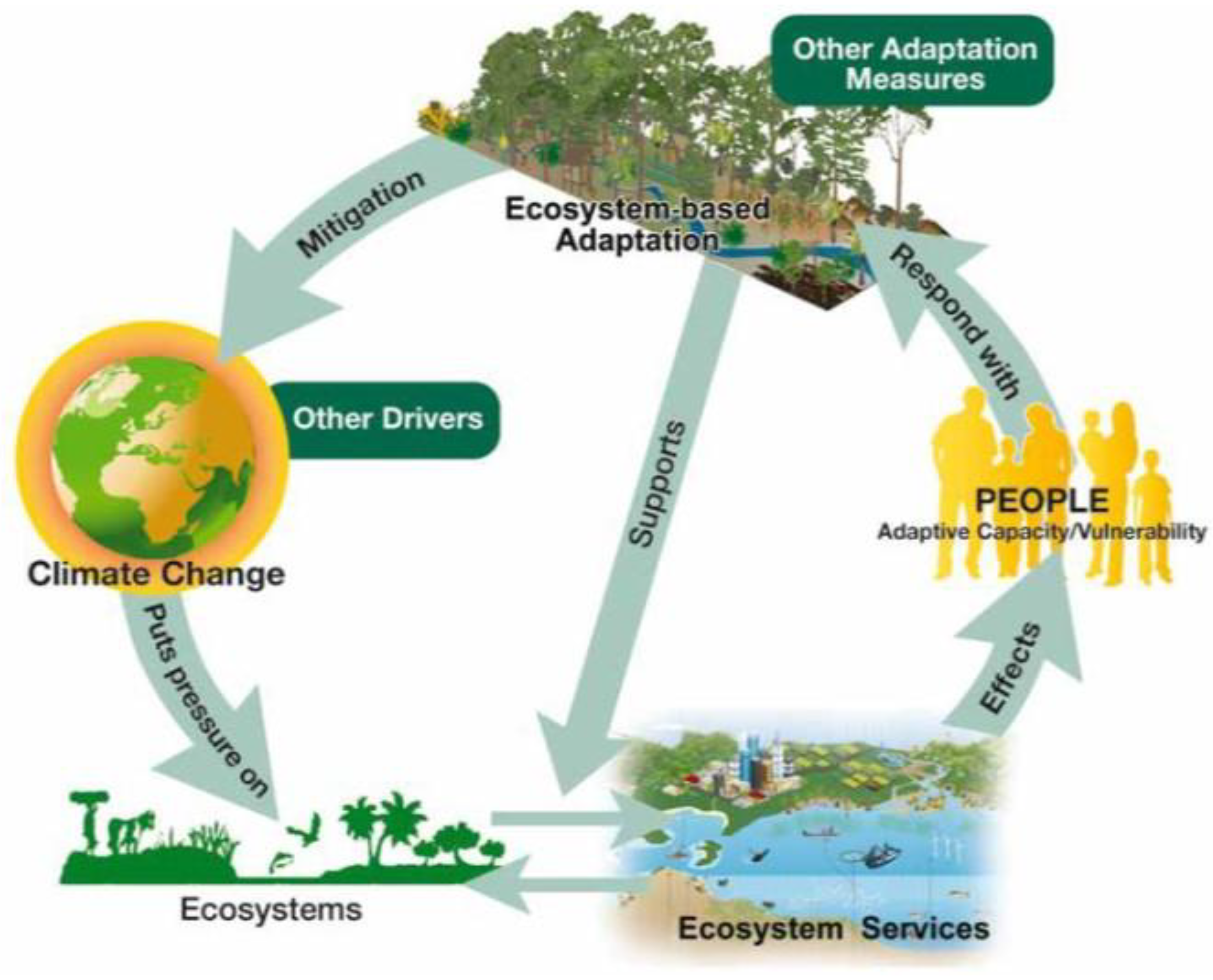
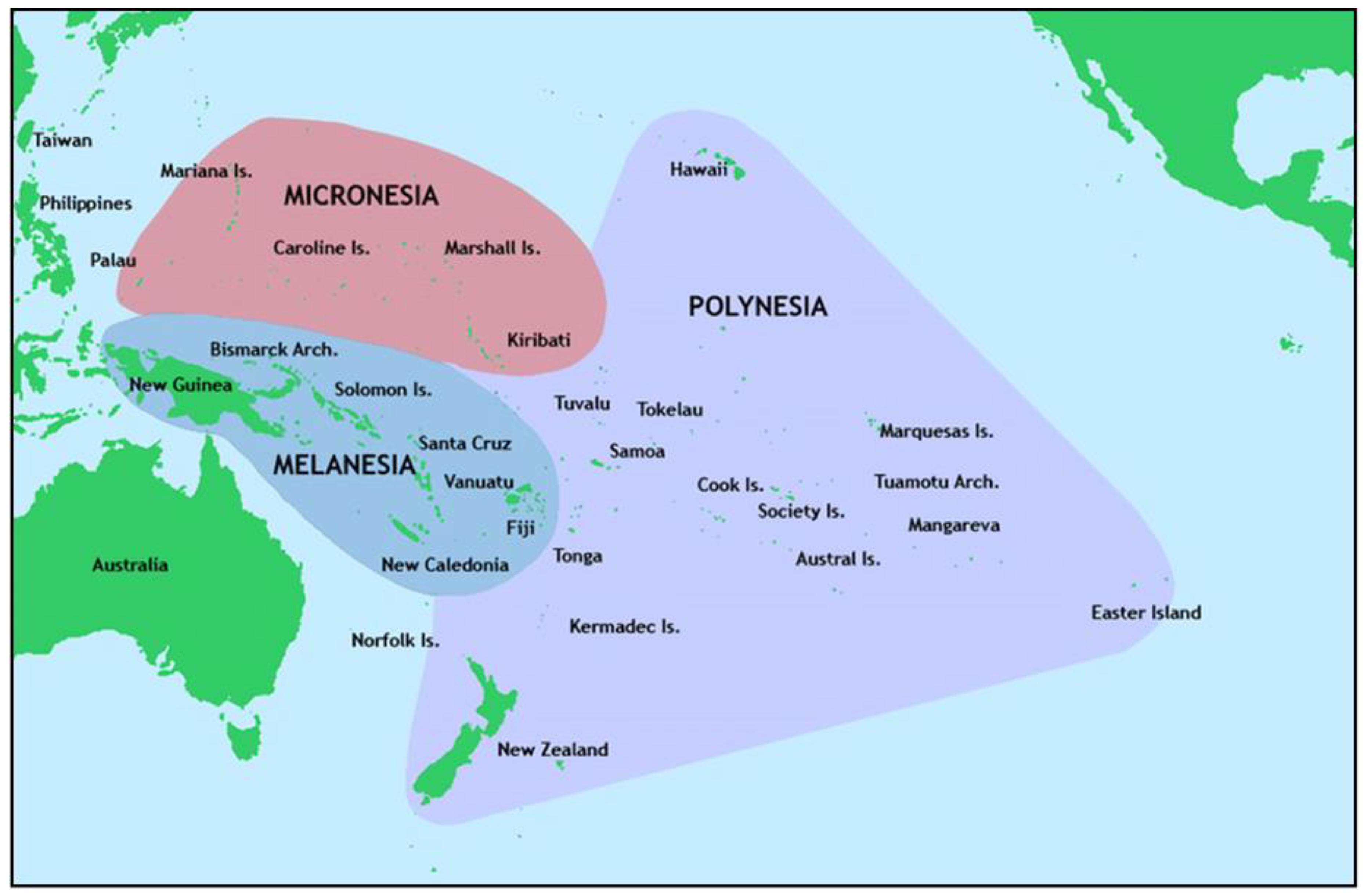
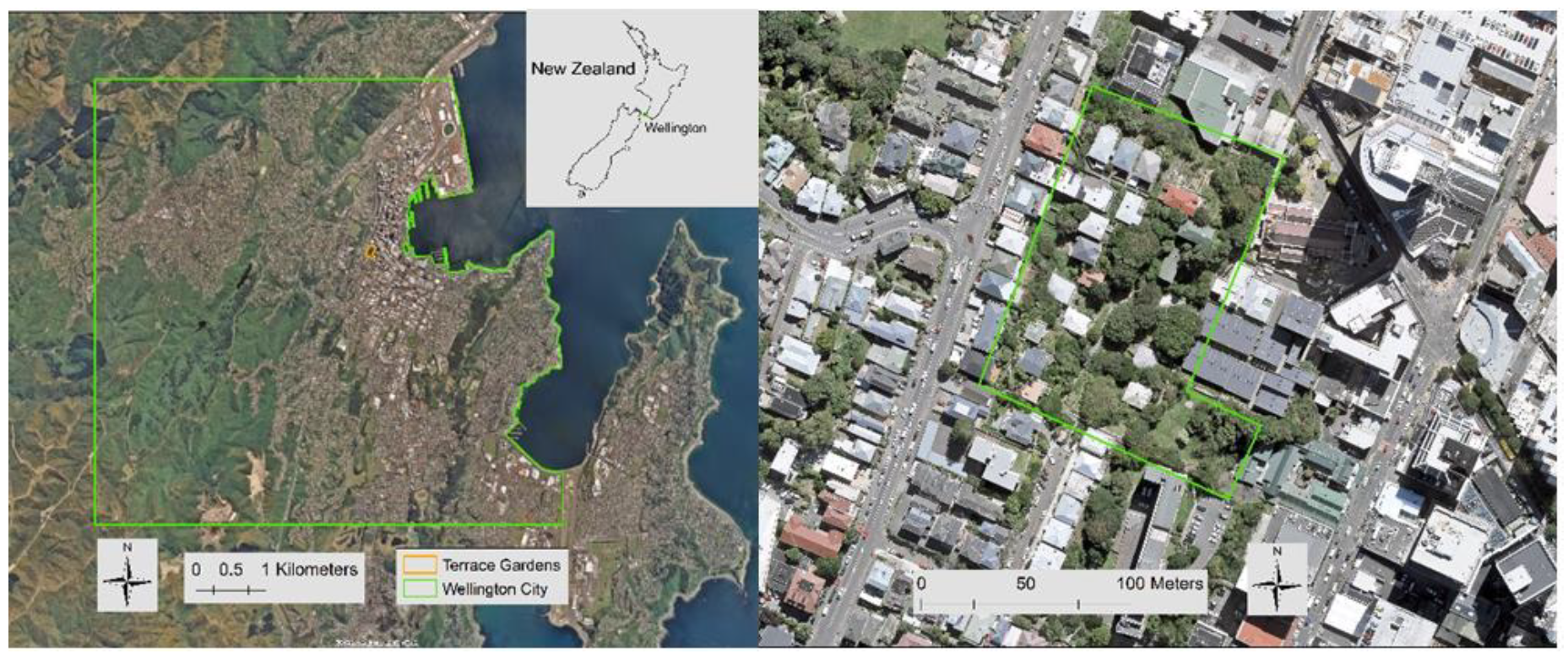


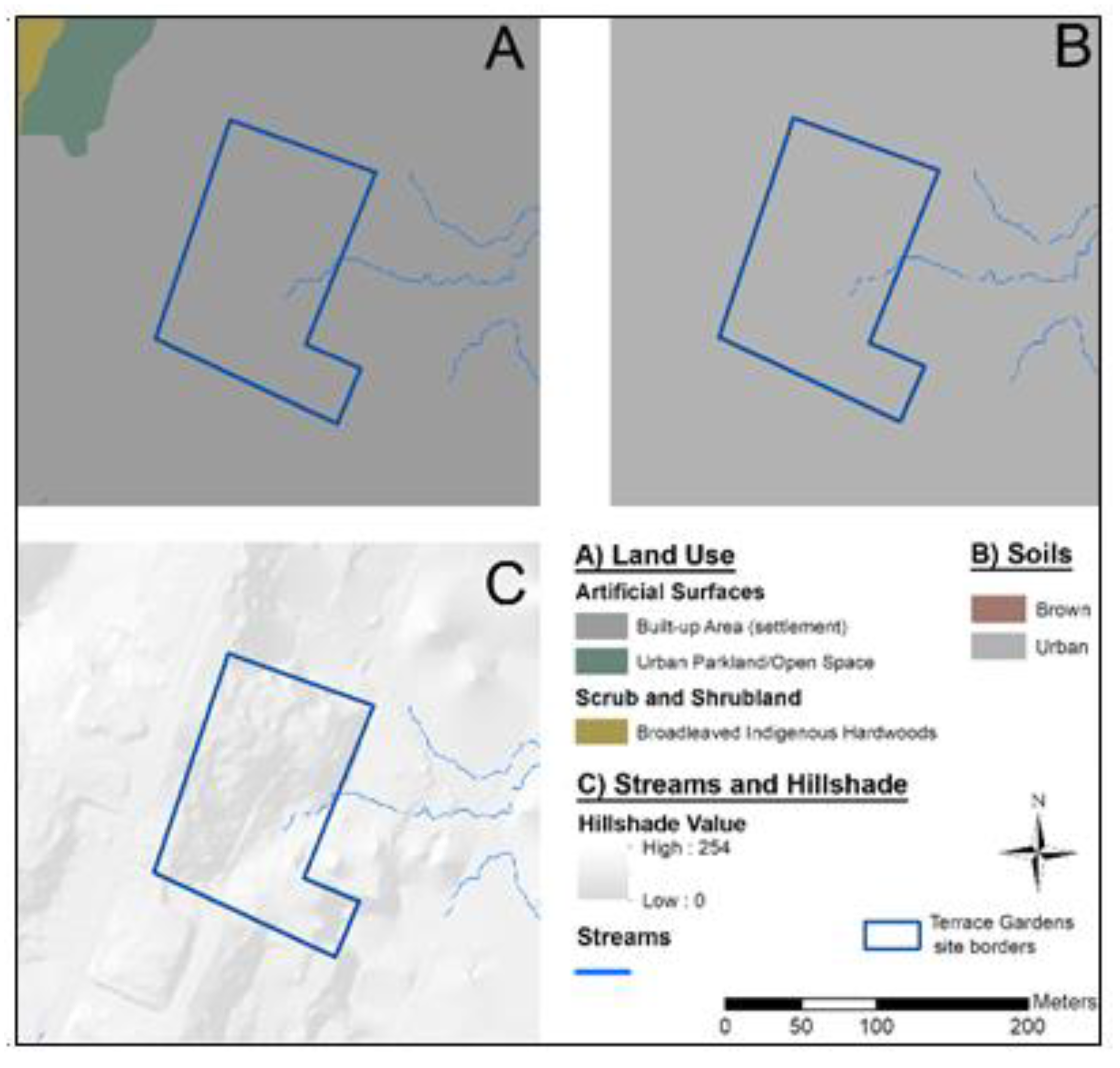
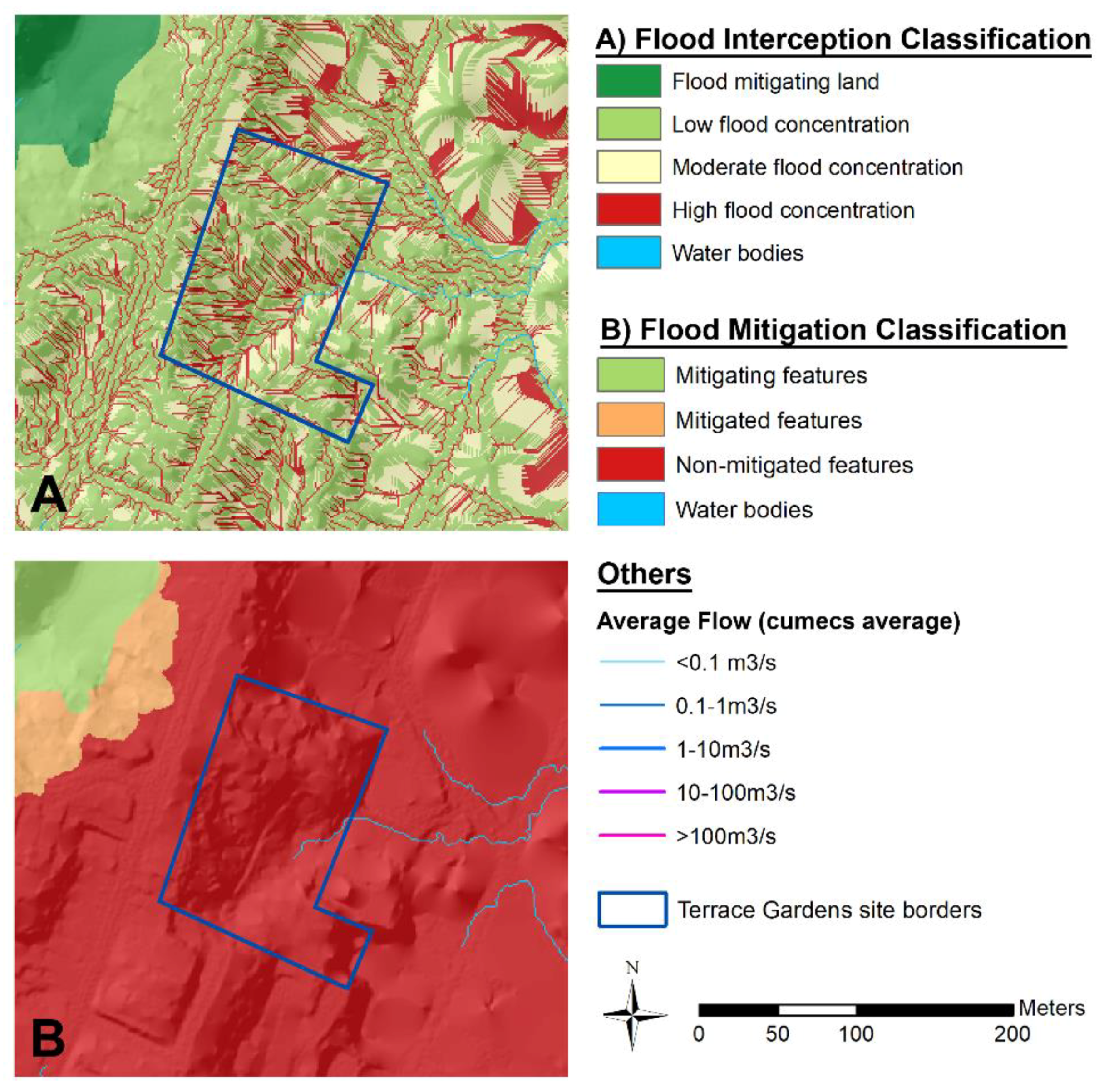
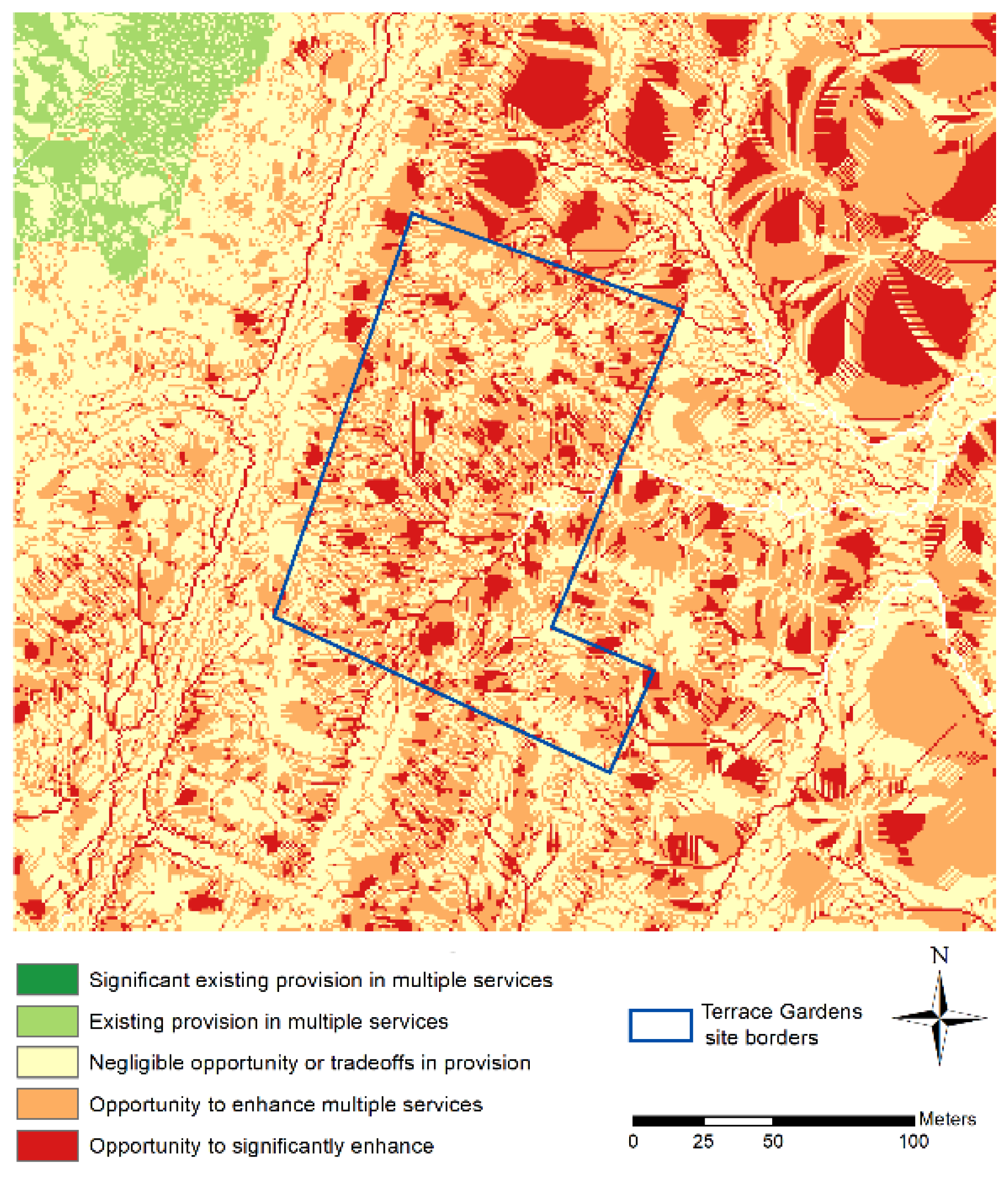
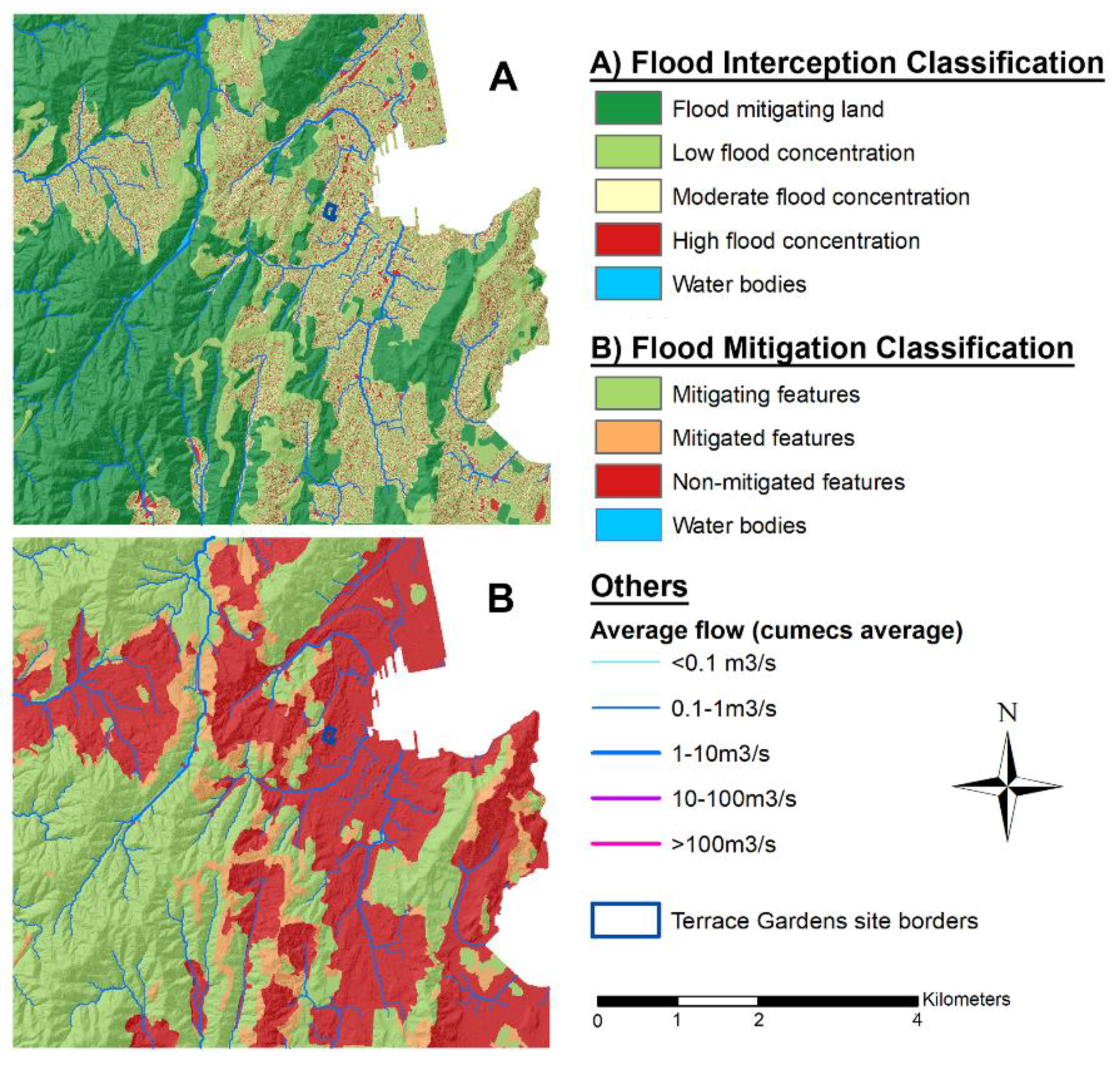
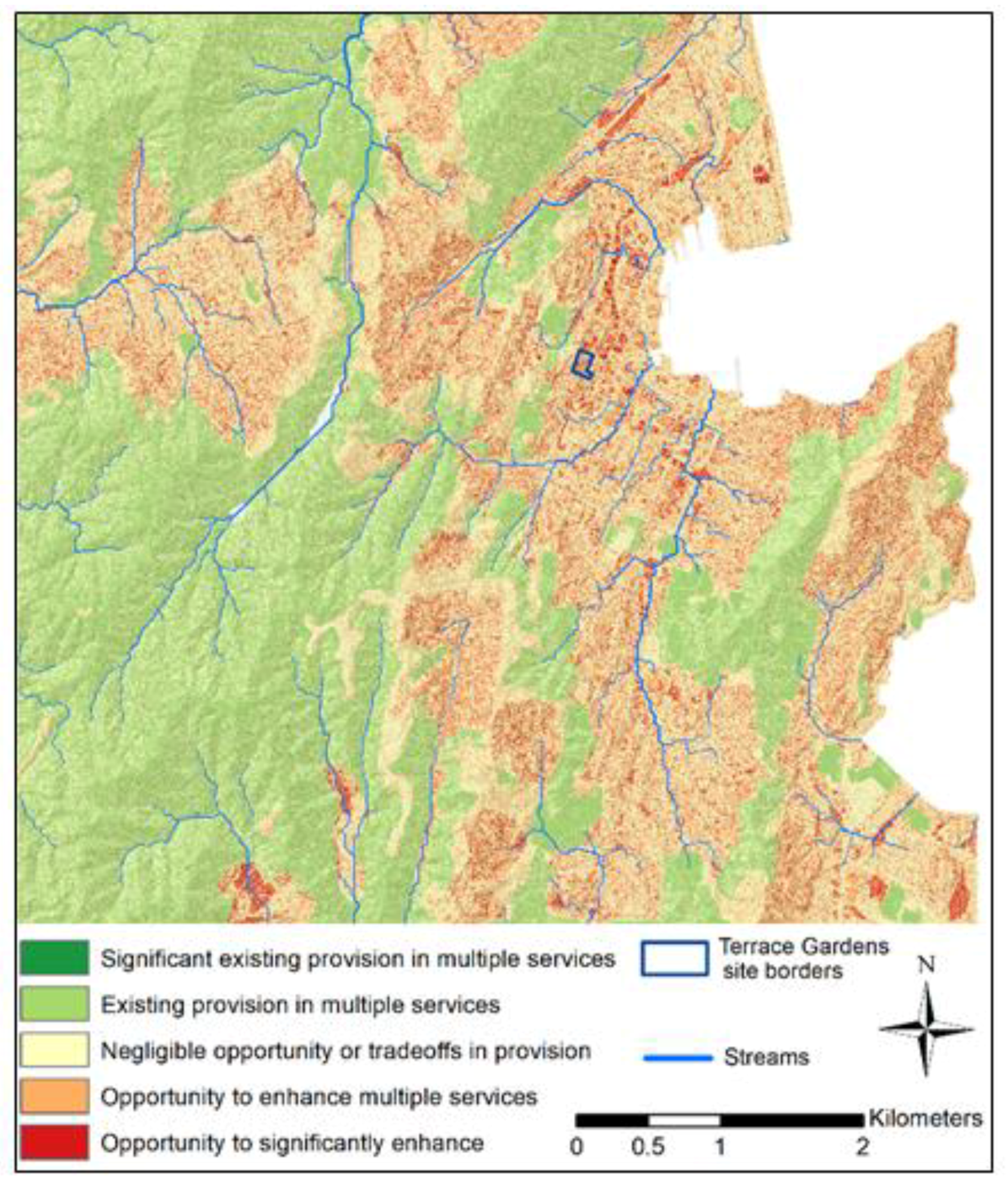
| Criteria | Type of Tools Excluded |
|---|---|
| Ready to use | Prototypes, tools under development, or those not available anymore |
| Generalisable | Tools that are not applicable across a variety of social–ecological settings and tools that are restricted to specific application in a single sector (e.g., agriculture, planning for policy) |
| Availability | Proprietary tools |
| Reviewed in literature | Tools with very limited information available to public |
| Consider multiple ecosystem services | Tools that only consider/examine only a single ecosystem |
| Criteria | Type of Tools Excluded |
|---|---|
| Preference for small scale and good resolution | Tool limited to scale larger than regional |
| Biophysical assessment | Tools that do not provide biophysical assessment of ecosystem services. Monetary and social value are secondary outputs |
| Spatially explicit outputs | Tools that do not provide spatially explicit outputs |
| Easy to interpret outputs | Tools that only provide absolute values without further information |
| Applicable independently | Tools that require skill typically beyond urban designer and architect expertise. GIS-related skills are acceptable, whereas economic expertise is not for example |
| Affordability | Tools that require large financial investment. This did not exclude software such as ArcGIS which is commonly accessible to designers |
| Input Data | Description | Source |
|---|---|---|
| Digital elevation model | DEM derived from LiDAR (1 m resolution) | Land Information New Zealand (2013) [40] |
| Land cover | Land Cover Database v5.0 | Land Resource Information Systems (2020) [41] |
| Soil information | Fundamental Soils Layer | Land Resource Information Systems (2010) [42] |
| Stream network | River Environmental Classification v2.0 | National Institute of Water and Atmospheric Research (2010) [43] |
| Rainfall | Virtual Climate Station Network (VSCN) gridded data (0.5 km resolution) | National Institute of Water and Atmospheric Research (2018) [44] |
| Evapotranspiration | Derived from potential evapotranspiration data (0.5 km resolution) | National Institute of Water and Atmospheric Research (2018) [44] |
| Characteristic | ARIES | Costing Nature | InVEST | LUCI | |
|---|---|---|---|---|---|
| Application context | Generalisability | Medium (* High) | High | High | High |
| Application context | T, F, M | T, F | T, F, M | T, F | |
| Scalability | Local-Global | Local-National | Local-Global | Site-National | |
| Resolution | 50 m × 50 m | 100 m × 100 m | 10 m × 10 m | 1 m × 1 m | |
| Outputs | Monetary valuation | ✓ | ✓ | ✓ | |
| Type of outputs | A, R | R | A, R | A, R | |
| Trade-offs | ✓ | ✓ | ✓ | ||
| Scenario/Forecast | ✓ | ✓ | ✓ | ✓ | |
| Model | N° models within tool | 11 | 13 | 18 | 11 |
| Platform | GIS (Web-based*) | Web-based | GIS | GIS | |
| Model temporality | S, D | S | S | S | |
| Approach to uncertainty | ✓ | ✓ | ✓ | ||
| Ecosystem Services Assessed by Tool | ARIES | Costing Nature | InVEST | LUCI | |
|---|---|---|---|---|---|
| S | Habitat (quality and provision) | ✓ | ✓ | ||
| R | Biological control (pest or disease regulation) | ✓ | |||
| Carbon (storage and sequestration) | ✓ | ✓ | ✓ | ✓ | |
| Climate regulation | ✓ | ||||
| Erosion control, landslide risk, soil stabilisation | ✓ | ✓ | ✓ | ✓ | |
| Flood mitigation | ✓ | ✓ | ✓ | ✓ | |
| Pollination | ✓ | ✓ | ✓ | ||
| Sediment regulation/delivery | ✓ | ✓ | ✓ | ||
| Urban Cooling | ✓ | ||||
| Urban Flood mitigation | ✓ | ✓ | |||
| Water (quality, purification, or nutrient regulation) | ✓ | ✓ | ✓ | ||
| P | Agriculture or aquaculture | ✓ | ✓ | ✓ | |
| Energy/fuel (fuelwood, solar, hydro, wind, wave) | ✓ | ✓ | |||
| Food (harvested wild goods, hunting or fisheries) | ✓ | ✓ | ✓ | ||
| Raw materials (timber, grazing, fibre, minerals) | ✓ | ✓ | |||
| Water (quantity, yield or provision) | ✓ | ✓ | ✓ | ✓ | |
| C | Aesthetic value | ✓ | ✓ | ✓ | |
| Recreation | ✓ | ✓ | ✓ | ||
Publisher’s Note: MDPI stays neutral with regard to jurisdictional claims in published maps and institutional affiliations. |
© 2021 by the authors. Licensee MDPI, Basel, Switzerland. This article is an open access article distributed under the terms and conditions of the Creative Commons Attribution (CC BY) license (http://creativecommons.org/licenses/by/4.0/).
Share and Cite
Delpy, F.; Pedersen Zari, M.; Jackson, B.; Benavidez, R.; Westend, T. Ecosystem Services Assessment Tools for Regenerative Urban Design in Oceania. Sustainability 2021, 13, 2825. https://doi.org/10.3390/su13052825
Delpy F, Pedersen Zari M, Jackson B, Benavidez R, Westend T. Ecosystem Services Assessment Tools for Regenerative Urban Design in Oceania. Sustainability. 2021; 13(5):2825. https://doi.org/10.3390/su13052825
Chicago/Turabian StyleDelpy, Fabian, Maibritt Pedersen Zari, Bethanna Jackson, Rubianca Benavidez, and Thomas Westend. 2021. "Ecosystem Services Assessment Tools for Regenerative Urban Design in Oceania" Sustainability 13, no. 5: 2825. https://doi.org/10.3390/su13052825
APA StyleDelpy, F., Pedersen Zari, M., Jackson, B., Benavidez, R., & Westend, T. (2021). Ecosystem Services Assessment Tools for Regenerative Urban Design in Oceania. Sustainability, 13(5), 2825. https://doi.org/10.3390/su13052825







